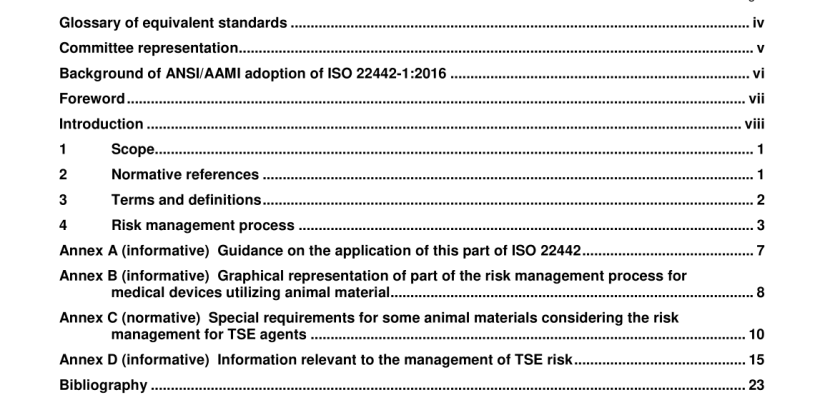ANSI AAMI ISO 22442-1-2016 pdf download
ANSI AAMI ISO 22442-1-2016 pdf download.Medical devices utilizing animal tissues and their
derivatives
1 Scope
This part of ISO 22442 applies to medical devices other than in vitro diagnostic medical devices manufactured utilizing materials of animal origin, which are non-viable or have been rendered non-viable. It specifies, in conjunction with ISO 1 4971 , a procedure to identify the hazards and hazardous situations associated with such devices, to estimate and evaluate the resulting risks, to control these risks, and to monitor the effectiveness of that control. Furthermore, it outlines the decision process for the residual risk acceptability, taking into account the balance of residual risk, as defined in ISO 1 4971 , and expected medical benefit as compared to available alternatives. This part of ISO 22442 is intended to provide requirements and guidance on risk management related to the hazards typical of medical devices manufactured utilizing animal tissues or derivatives such as
a) contamination by bacteria, moulds or yeasts;
b) contamination by viruses;
c) contamination by agents causing Transmissible Spongiform Encephalopathies (TSE);
d) material responsible for undesired pyrogenic, immunological or toxicological reactions.
For parasites and other unclassified pathogenic entities, similar principles can apply. This part of ISO 22442 does not stipulate levels of acceptability which, because they are determined by a multiplicity of factors, cannot be set down in such an International Standard except for some particular derivatives mentioned in Annex C. Annex C stipulates levels of TSE risk acceptability for tallow derivatives, animal charcoal, milk and milk derivatives, wool derivatives and amino acids. This part of ISO 22442 does not specify a quality management system for the control of all stages of production of medical devices. This part of ISO 22442 does not cover the utilization of human tissues in medical devices. NOTE 1 It is not a requirement of this part of ISO 22442 to have a full quality management system during manufacture. However, attention is drawn to International Standards for quality management systems (see ISO 1 3485) that control all stages of production or reprocessing of medical devices. NOTE 2 For guidance on the application of this part of ISO 22442, see Annex A.
4.4.2 Risk control for viruses and TSE agents
Risk control shall be implemented by separately addressing the risks related to different categories of viruses and TSE agents. After defining the characteristics of the product, the medical device manufacturer shall comply with the relevant requirements of both ISO 22442-2 and ISO 22442-3, except where either the animal species is such that manufacturers cannot fully meet the requirements of ISO 22442-2 or an inactivation process in accordance with ISO 22442-3 would cause unacceptable degradation. Tallow derivatives, animal charcoal, and amino acids that are acceptable for TSE risk as discussed in Annex C, due to their processing and not their sourcing, shall also be considered to have acceptable risk regarding viruses. Regarding TSE risk, risk control measures specified in Annex C for certain animal materials shall be applied where relevant. If the manufacturer considers any requirement not to be relevant, the rationale and justification shall be documented. For medical devices where an inactivation process causes unacceptable degradation, manufacturers may rely on ISO 22442-2 in order to meet the requirements of this part of ISO 22442. If the animal species is such that manufacturers cannot fully meet the requirements of ISO 22442-2, they shall demonstrate that the level of inactivation of transmissible agents in a validated manufacturing process, as required in ISO 22442-3, is sufficient to achieve an acceptable level of risk. NOTE Criteria and principles relevant to the management of TSE risks are described in Annex D. Annex D contains information on relevant risk control measures.
